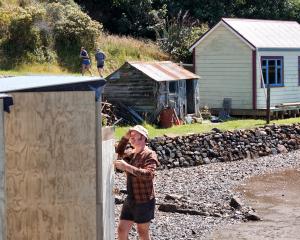"Now is the time when the phones start to ring," confirms Gavin Mead, president of the Otago branch of Master Painters New Zealand. "But people in business quite a while will also have ongoing work with [long-term] clients."
Mr Mead says the public can be divided into three groups - those who have an ongoing relationship with a tradesman they trust, those who get multiple quotes and take the cheapest, and those who are confident enough in their abilities to tackle the job themselves.
A paint job should last five to seven years, improving the look of your home and protecting it against the elements. But it is easy to underestimate the amount of work involved.
"Inside can be done room by room and you don't see too much mess whereas the outside, if it's a turn-of-the-19th-century villa, would be a big ask for a homeowner," says Mr Mead, adding that if the villa happens to be two storeys, you could easily spend 100 hours just on preparation.
Not surprisingly, he says professionals are often called in to finish the job or do "just the hard bits" requiring long ladders or scaffolding.
When choosing a painter, he recommends checking who they have previously worked for and asking those customers how they performed.
A registered master painter comes with a certificate to remove lead, all the necessary gear including scaffolding, and the ability to do a professional job.
Costs vary widely but average $40 to $45 an hour.
"You might find [someone] with a cheaper hourly rate but you get what you pay for."
Dulux Paints training manager Bevan Tutty says if painting the house seems too daunting, finish one side completely and that will get you "enthused" for what the rest will look like.
Preparation is the most important part of painting, Mr Tutty adds. First, remove all dirt and grease by washing the surface with sugar soap, rinsing it with water and allowing it to dry. Then remove any old loose or peeling paint by sanding, scraping or using a wire brush .
Fill any holes or cracks with an appropriate filler, wiping flexible filler with a wet cloth while it is still wet or letting rigid filler dry, then sanding it smooth.
Once you have a clean, sound, smooth surface, apply your undercoat. To ensure paint sticks properly to glossy surfaces, sand to a matt finish. Dust the surface down thoroughly and you are now ready for the top-coats. Follow the directions on the paint label and if you need extra advice, call the manufacturer's customer-service number.
Always stir paint thoroughly and allow for the full drying time between coats.
Don't paint when the air or surface temperature is below 10degC. If your washing won't dry on the clothesline, your paint won't dry either.
When painting on bare surfaces or going for a drastic change in colour, it is best to prime or undercoat. In all cases, apply two top-coats to ensure complete coverage.
Waterborne paint is touch-dry in 20 minutes and oil-based paint in six hours but both take three to seven days to "cure" or to reach their true hardness and sheen level.
HOW MUCH PAINT?
How to calculate how much paint you will need:
• Measure the height and width of each area.
• Multiply the height by the width to find the number of surface square metres.
• Look at the paint-can label for the number of square metres each litre covers.
• Divide that into the number of square metres to obtain the number of litres of paint per coat.
• Then add: 20% for rough and porous surfaces, 10% for narrow weatherboards, 33% for corrugated metal or 10% for the first coat on a concrete-block masonry wall.
• For pitched roofs, measure the floor area of the house, including any covered verandas and the like, then add 60% of that surface area to allow for pitch and corrugations.
THE RIGHT TOOLS
Using the right tools is the key to a good finish.
• Rollers are commonly used on roughcast surfaces while a brush gets into nooks and crannies and spraying is often the fastest method of application on broad and difficult surfaces.
• Choosing the right brush: 12mm to 25mm for small jobs such as chairs; 38mm for furniture, skirting and trellis; 50mm for doors and windows; 63mm for outdoor furniture; 75mm for fence posts, steps and trim; 100mm for walls, roofs, fences and floors.
• Rollers should have a sturdy frame and be washed before first use: Use a 5mm pile for gloss and semi-gloss paints on a smooth surface; 8mm pile for semi-gloss, low-sheen and matt paints on walls and ceilings; 12mm pile for low-sheen and matt paints on walls with a textured surface; 20mm pile for rough surfaces.











